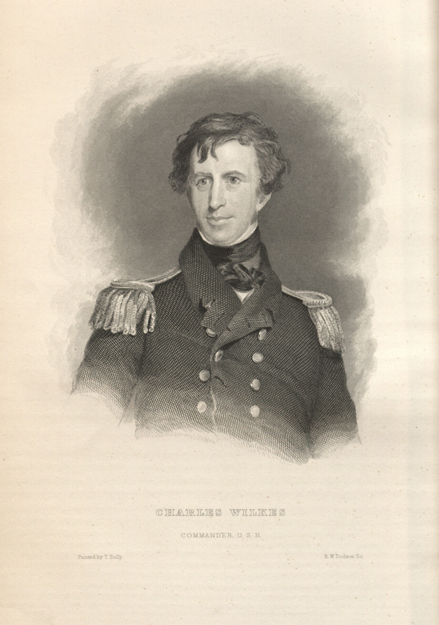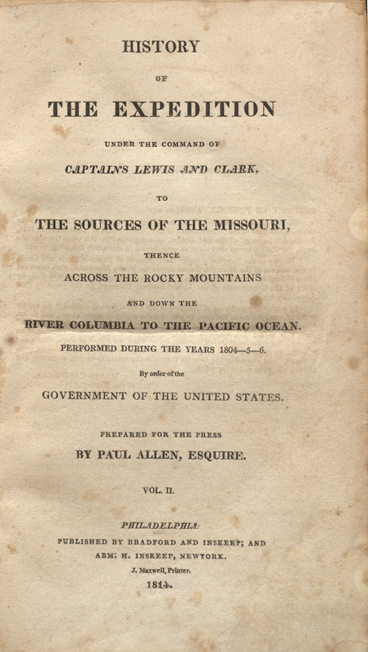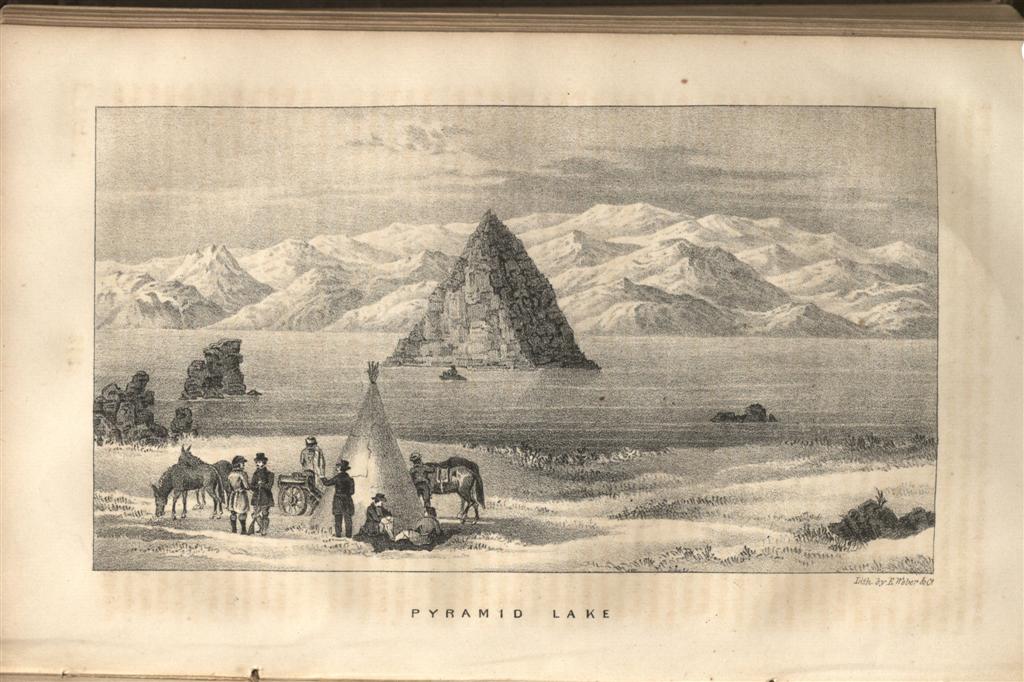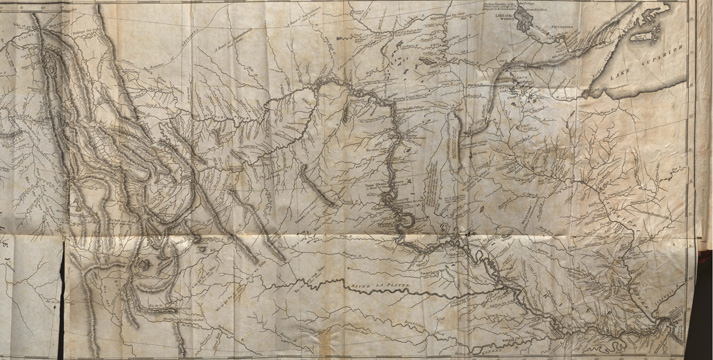|

|
Table
of Contents
Explorations
of the West
Sam
Dalsheimer
Caitlin
Goss
Nick
Schradle
David Sena
Representations
of
Native Americans
Richard
Dybas
Amanda Leong
Cynthia
Robertson
The
Western Railroads
Ronni Toledo
Kayt
Fitzmorris
Jon Ingram
David
Halperin
The
California
Gold Rush
Jordan Helle
Adam
Lawrence
Marisa
Pulcrano
Patrick Ryan
California
as Western Destination/
Mediterranean Boosterism
Maddy
Kiefer
Danielle
Mantooth
Molly
Nelson
Stefanie Ramsay
Other Online
Exhibits
|
Introduction
The exploration texts of Lewis and
Clark, John C. Fremont, and Charles
Wilkes demonstrate a large array of
American sentiments of the early
19th century towards the frontier.
In these texts there is an
increasing audacity in tone as the
explorers grow more confident with
the lay of the land.[more]
This confidence is indicative of the
United States’ growing comfort with
the western territories and its
changing values as seen through the
doctrine of Manifest Destiny. All
four expeditions were sponsored by
the United States government with
very strict goals of cataloging the
landscape and wildlife (the natives
also being part of the “wildlife”)
and how to best manipulate them. The
language of these narratives is
scientific and analytical on all
accounts but especially towards
Native Americans. What started as a
gentle yet patronizing interest by
Lewis and Clark turned into scorn
and distrust in Fremont and finally
transformed into Wilkes’ near
blatant racism towards the natives
and espousal of white superiority.
Also distinguishing these texts is
the fact that they were all written
by military men. Their training and
propensity to evaluate situations
based on fulfilling the United
States government’s expectations not
only make for highly
professionalized documents but also
indicate a martial attitude towards
the domination of a land and its
people.
|
|

Narrative of The United
States Exploring
Expedition:
During the
years 1838, 1839, 1840,
1841, 1842

- Sam Dalsheimer
"Charles Wilkes:
The Most Intrepid Man of All
Time"
The United States Naval
officer, Charles Wilkes was
tapped by the U.S.
government in 1836 to lead a
large group of scientists,
artists and linguists, to
explore coastlines, islands,
and the general periphery of
the United States
territory. His
officially penned
documentation, the Narrative of the
United States Exploring
Expedition,
is an expansive text (much
like the frontier) covered
in five volumes each, each
reaching over five hundred
pages. Wilkes and his
men journeyed from Virginia,
circumnavigating South
America, and eventually
reached Fiji, Hawaii,
Vancouver, Oregon,
California, and numerous
South East Asian islands.
The illustrations in every
volume are exquisite.
The depictions of craters
and volcanoes in Hawaii are
particularly
mesmerizing. When in
Oregon, Wilkes expounds on
the “primeval forest of
pines in the rear of
Astoria,” noting the largest
tree to have a circumference
of thirty-nine feet six
inches; a camera lucida
drawing by one of their many
artists, J. Drayton, gives
an impressive sense of the
scale of these towering
pines.[1]
Throughout the
narrative Wilkes employs a
very methodical and
scientific approach to
writing. This of
course fits well when
cataloging the flora, fauna,
and geography, but he
carries the same tone when
describing the native
population. Even at
his most pro-Indian, Wilkes
uses dehumanizing, technical
words. He describes
their native pilots, Ramsey
and his brother George, as
“good specimens of Flathead
Indians;” furthermore, he
was “pleased at having the
opportunity” to include
sketches of them,[2] much
like the drawings of plant
life that litter the rest of
the document.
There are times when Wilkes’
racism is shockingly
blunt. At one point he
describes the “vicious
propensities” of the
indigenous population in
Astoria:
Both sexes are equally
filthy, and I am inclined to
believe will continue so;
for their habits are
inveterate, and from all the
accounts I could gather from
different sources, there is
reason to believe that they
have not improved or been
benefited by their constant
intercourse with the whites,
except in very few cases. It
is indeed probable that the
whole race will be
extinguished ere long, even
if no pestilential disease
should come among them to
sweep them off in a single
season. [3]
This is admittedly one of
the more extreme examples of
racism in the text, but it
is intriguing nonetheless,
especially when analyzed via
postcolonial theory. Wilkes
engages in Orientalist
discourse by analyzing the
natives, “not as citizens,
or even people, but as
problems to be solved or
confined or as the colonial
powers openly coveted their
territory–taken over."[4] Of
particular note is his
interpretation of
miscegenation, which plainly
acknowledges a belief that
whiteness would bring some
sort of “improvement” to the
lives of natives.
Regardless of the inherent
racism in the text, Charles
Wilkes’ writes with a
professionalism that many
original source accounts
lack. In particular,
the attention to detail is
impressive for such a
massive endeavor. If
we ignore the fact that
Wilkes considers Indian aid
as some auxiliary effort to
the expedition much of the
time, we can see that
indigenous groups were
incredibly helpful–at times
essential–in making the
travels possible; within
every few pages, trade with
Indians is mentioned.
Wilkes’ rhetorical
choices—in depicting the
indigenous
population—further
legitimize the continued
colonization of the American
landscape in the
mid-nineteenth century.
Return to Top
|
|

History of the expedition
under the command of
Captains Lewis and Clark,
to the sources of the
Missouri, thence across
the Rocky Mountains and
down the River Columbia to
the Pacific Ocean,
Performed during the years
1804-5-6

- Caitlin
Goss
"Lewis and Clark
Explore the West"
The exploration of the west
is a hefty topic and one
that can be theorized in
many ays from the
ideologies of Frederick
Jackson Turner’s rugged
frontierism[1] to William
Cronan’s metropole[2] of
tight cities surrounded by
concentric circles of lesser
developed outer ring
villages, expanding outward
to the frontier. But to gain
insight into the western
expansion from the
perspective of pioneering
Americans, it is best to
turn the yellowed pages of a
primary text, in this case,
that of the History of
the Expedition under the
Command of Captains Lewis
and Clark. This text
provides a first person
narrative of the westward
travels of Lewis and Clark
and presents vivid
descriptions of the
environment and of the
natives they encounter.
Because the expedition was
assigned by the United
States government as a sort
of exploratory mission,
Lewis’ writing presents a
professionalized and
analytical perspective on
the environment and the
natives that inhabit it.
From the illustrative
narration of their
encounters with the natives,
Lewis and Clark seem to have
been a part of what Richard
White refers to as
“the middle ground”[3] of
the west, interacting with
the Native Americans in a
way that allowed for the
exchange of goods and
friendly hospitality. For
example, Lewis narrates an
occasion in which their
group was visited by several
natives upon which he
recalls, “we received them
kindly, smoked with them,
and gave them a piece of
tobacco to smoke with their
tribe…our two chiefs had
gone on in order to apprise
the tribes of our approach
and of our friendly
dispositions towards
them"[4]. The explorers were
cordial and welcoming in
cases such as this,
practicing the traditional
signs of peace and
friendship between
themselves and the Natives.
During their travels, Lewis
narrates their encounters
with the Indians, which are
seemingly friendly and
helpful interactions. Upon
meeting a tribe, for
example, the Lewis and Clark
group would honor the native
chiefs with presents and
would follow the practice of
smoking with the group as a
sign of friendship. Lewis
described the natives with
much detail and described to
great extent the differences
between each tribe they came
into contact with in regards
to physical countenance and
dress and the set up of
their villages. This is an
important note in regards to
the outlook of Lewis on the
natives. The natives were
not lumped into the broad
category of wild ‘savages’
but were instead studied in
regards to appearance,
language, health, diet, and
culture perhaps in a more
scientific and analytical
way than that of other
explorers who had different
intentions in their travels.
This may indicate a sort of
interest in the natives that
other frontiersman may not
have had. Lewis’ narrative
of his expedition offers the
perspective of the Captains
in regards to the frontier
and the movement west and
the exploration of both the
environment and the people
and cultures within it.
[1] Turner,
Frederick Jackson. “The
Significance of the
Frontier in American
History.” Report of
the American
Historical Association
for 1893. Pgs.
199-227 (AHA, 1893)
Return
to Top
|
|

Report of the exploring
expedition to the Rocky
Mountains in the year 1842,
and to
Oregon and North
California in the years
1843-44

- Nick
Schradle
In the mid-1840s,
the United States Congress
sponsored the first of
several expeditions into the
largely unexplored interior
of the United States. John
C. Frémont's Report
of the exploring expedition
to the Rocky Mountains in
the year 1842, and to Oregon
and North California in the
years 1843-44 details two of
these expeditions. The first
expedition commenced in
1842—following a western
course that would later be
known as the iconic Oregon
Trail—but stopped at the
South Pass of the Rocky
Mountains. The second
expedition, which lasted
from 1843-1844, followed the
same route but continued
into Oregon territory, then
circled Southward through
the Sierra Nevada into
California.
Frémont's
report consists of daily
journal entries which
recounted the day's
occurrences and also
recorded data such as
temperature, topography,
soil composition, geographic
coordinates, flora and
fauna, and various other
information. A number of
detailed illustrations,
mostly of impressive
landscapes, sporadically
accompany journal entries.
At the end of either
expedition's account are
extensive appendices
cataloging and expanding on
the data recorded in
Frémont's daily
entries.
Surprisingly, the majority
of the men in either of
Frémont's expeditions
were French-Canadian
“voyageurs.” The fact that
this introduced an
unnecessary language
complication to the
expeditions is at first
puzzling. However, it is
likely that these men had
valuable practical
experience with the frontier
in general and the interior
of the country in
particular—perhaps from
years spent trapping.
However, the extent of the
expeditions' collective
wisdom was at times
questionable. The expedition
of 1843-44 attempted to
cross the snow-bound Sierra
Nevada in the dead of
winter—despite clear
warnings from local Natives
to avoid such an
undertaking—and nearly
starved to death.
At the time of these
expeditions, the land west
and south of the Rocky
Mountains was still Mexican
territory. However, no
concern with or even
recognition of this apparent
(government sponsored)
incursion appears in
Frémont's accounts.
By the mid-century, the
territorial ambitions of the
United States accelerated
along with the ascension of
the ideology of Manifest
Destiny in American culture.
Frémont was a
harbinger of this powerful urge to
expand westward, an urge
that would lead to war with
Mexico only a few years
after the expeditions'
conclusion.
Frémont's encounters
with, and attitudes toward,
Native Americans on the
“frontier” is also
tragically indicative of
events and attitudes to
follow in the Indian Wars of
the mid-to-late 19th
century. The expeditions'
encounters with Natives were
almost always tense, and
usually balanced on the edge
of violence.
The gradual colonization of
the Eastern seaboard by
Euro-Americans began in the
16th century, immediately
impinging upon the
settlements of Native
Americans. Initially, a
“middle ground” developed
between Natives and
Euro-Americans that had
necessitated a degree of
cultural toleration and
political respect between
the two groups (see The
Middle Ground by Richard
White). However, this
gradually dissolved under
the consistent pressure
exerted by settlers on the
resources and land around
Native settlements. This
pressure had dire
consequences—disease and
warfare amongst Native
groups and between Natives
and settlers inevitably
decimated Native populations
and displaced Native groups
out of territory familiar to
them. By the mid 19th
century, existing
populations of Native
Americans also faced
considerable organized
discrimination from the
United States Government.
Most notably, the Indian
Removal Act of 1830 gave
President Andrew Jackson the
authority to forcibly remove
large populations of
Cherokee, Chickasaw,
Seminole, and Choctaw
Natives from the Deep South
and confine them to
relatively small territory
in present day Oklahoma.
The volatile nature of the
encounters between Native
groups and Frémont’s
expeditions was directly
related to the Natives’
displacement and conflict
with both settlers and those
in the employ of the U.S.
Government in the preceding
decades. Frémont,
however, does not display
cognizance of this fact or
sensitivity to the culture
or situation of Native
Americans. Incredibly, only
one man, and not Natives,
were killed in conflict with
Native groups over the
course of either expedition.
If at any point violence had
broken out on a larger
scale, Frémont and
his men were at a
considerable numerical
disadvantage and risked
annihilation. It is no
surprise that, despite the
ostensibly scientific aims
of the expedition, the
company carted an unwieldy
Howitzer canon over the
thousands of miles of rough
terrain. Tragically,
Frémont’s expedition
marked the beginning of the
U.S. Government’s
increasingly militant
expeditions into the
interior of the country.
These forays would
eventually escalate into the
Indian Wars of the mid to
late 19th century, in which
U.S. Army systematically
killed thousands of Native
Americans.
Return
to Top
|
|

History of the expedition
under the command of
Captains Lewis and Clarke,
to
the sources of the
Missouri, thence across
the Rocky Mountains and
down the River Columbia
to the Pacific Ocean.
Performed during the
years 1804-5-6. By order
of the government of the
United States Vol
I
- David Sena

"Orientals
in America"
Lewis and Clark in their
seminal 1804 expedition
found themselves in the
unique position of being a
stranger in a land that
now-Americans had known
about as part of a continent
that they had lived on for
more than 200 years.
Being one of the last
episodes of “first contact”
between Native Americans and
a Western power (in the form
of the new United States),
many of the same tendencies
towards “orientalism” that
had been present in earlier
contact zones of the 16th
and 17th centuries occurred
one more time in a way that
subtly persuaded many to
heed what had for years been
a siren call from the
West.
Meriwether Lewis
particularly as the
expedition’s “scribe” had a
great interest in conveying
the ebullient grandeur of
the land near the Missouri
River and its resources in
what he often described as a
“near paradise” (Lewis, 78)
full of great “abundance
with fish, game and tree of
all sorts” (Lewis, 78) that
stood in sharp contrast to
the settled and more stale
cityscapes which he came
from. Even when the
expedition was rough and
survival was not always
guaranteed, Lewis was
obsessed with meticulously
and mechanically describing
every aspect of his
environment in an effort to
try to understand all of its
inner workings, frequently
commenting on its “amazing”
peculiarities (all
throughout but here Lewis,
98). This fascination
with a new place of such
perceived magnificence and
treatment of it from the
perspective of a detached
and omniscient observer
engaging in empirical study
typifies one early way in
which Americans began to
take a sort of ownership of
the new frontier. In
believing in their ability
to understand a new
landscape and its mysteries,
the land can thus be
controlled and demonstrated
as being tamable.
These attitudes also
represent a voyeurism that
instantly whets the appetite
of any prospective pioneer
looking to engage with a
land of many fruits and
eccentricities and also
planted the seeds of later
imperialism.
Such mindsets even applied
to real human beings as
Lewis demonstrates through
the expedition’s dealings
with Native Americans in a
manner that severely though
subtly dehumanizes them
(though that was not
necessarily their conscious
reckoning). As
enthralled as he is with the
natural landscape, he is
just as captivated by the
“exotic nature” of Native
Americans (Lewis, 20).
He particularly sexualizes
Native American women,
taking great lengths in
detailing the way they dress
and how immodest they are
when it comes to wearing
revealing clothing. He
notes how the natives at one
village were all riddled
with venereal disease,
indicative to him of an
erotic and loosely
irresponsible people.
All Native Americans he
describes as being intrigued
by seemingly insignificant
and cheaply-made bronze
works like kettles and blue
beads which Lewis and Clark
were able to exchange for
needed food and
supplies. Both parties
thought they had got the
better deal from the
other. Although he
does not explicitly state
it, Native Americans seem to
Lewis like children who
engage in these “queer
behaviors” because they
simply do not know any
better way. This
orientalizing of an entire
race makes it very easy to
cast Native Americans as not
only undeveloped human
beings but also attracts
even more sentiment towards
settlement of the West in an
effort to observe and
possibly even engage in such
arousing and strange
activities independent of
government or constraining
society. Lewis
certainly felt he was being
impartial and frank, but his
underlying attitudes colored
his perspective and provided
the foundation for how the
United States viewed the
frontier as a place both
worth conquering and easy to
conquer.
Featured map:
This copy of a hand-drawn
map by expedition co-leader
William Clark, as objective
as it appears to be,
nevertheless hints at some
of Clark's
personal biases regarding the
land. From a top-down
perspective,
Clark intricately
details scores of natural
landmarks and
river routes giving
the land an
overwhelmingly abundant
feel. Yet from a
left-right perspective
the land is scaled to
seem far more compact
with the Pacific appearing
to be a much shorter
distance from Missouri
than as seen through
modern maps. The
Rocky Mountains themselves
appear to be an
afterthought. Perhaps
Clark intended
to depict a land full
of resources that is
nonetheless relatively easy
to traverse and quick to
travel through, a tempting
combination for prospective
settlers.
Return to Top
|
|
About
this Project / Acknowledgements
Occidental
College's "American Frontier"
Research Seminar was developed by
Dr. Jeremiah B.C. Axelrod, Adjunct
Assistant Professor of History.
The library project
is developed in collaboration with
the Special Collections
Department:
Dale Ann Stieber, Special
Collections Librarian
with student staff
Henry Boule and Claire Lem and
Laila Tootoonchi and Anahid
Yahjian.
Title Image:
Thomas Moran, "Nearing Camp,
Evening on the Upper Colorado
River, Wyoming, 1882," from
http://www.boltonmuseums.org.uk/collections/art/paintings_prints_and_drawings/oil/nearing_camp_moran
|
|
Page last edited on
03/12/2013.
Occidental
College Library Special
Collections & College Archives
© 2009 Occidental College
|
|
|
|
|